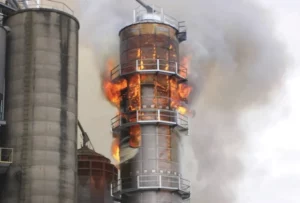PREVENTING AND RESPONDING TO GRAIN DRYER FIRES
 Grain dryer fires pose unique hazards to the grain handling industry. These fires can result in downtime, lost revenue, injury and possible death. It is imperative that each facility engaged in grain drying, develop and document an effective emergency response plan to deal with these incidents.
Grain dryer fires pose unique hazards to the grain handling industry. These fires can result in downtime, lost revenue, injury and possible death. It is imperative that each facility engaged in grain drying, develop and document an effective emergency response plan to deal with these incidents.
Causes
Grain dryers move high volumes of air through perforated screens that allow air to flow through the grain. Grain dryer fires are often caused by lack of operator training, lack of operating oversight, inadequate cleaning and running the dryer at high temperatures. It is imperative that each operator is properly trained on the operation of the dryer. Established operating procedures can be found in the equipment’s operations manual.
Prevention
Implementing a grain dryer preventive maintenance program reduces the likelihood of a dryer fire. The dryer’s operations manual includes preventive maintenance schedules that should be followed. Each grain dryer should have its own maintenance schedule utilizing a maintenance checklist. Preventive maintenance should be performed prior to, during, and after the drying season. Many dryer fires are the result of improper in-season maintenance. In-season maintenance activities should include routine cleaning of the dryer screens and inspection of emergency controls and associated equipment.
Emergency Response
Each facility engaged in grain drying should develop an emergency response plan specific to fires. The response plan will vary based on the type, manufacturer and model of grain dryer. The response plan should be included in the facility’s emergency action plan. Generally accepted emergency response actions include the following:
Notify the Fire Department
The first step when responding to a dryer fire involves notifying the local fire department. Many dryer fires are small in nature and can be extinguished quickly by facility personnel. However, some dryer fires spread rapidly and require additional resources. Regardless of the size of the fire, it is important to have the fire department on stand-by when implementing the dryer’s emergency response plan. This saves valuable response time should the fire spread rapidly beyond control.
Isolate the Equipment
Grain dryers are equipped with emergency shut-offs located at the dryer control panel or at the PLC controls. The emergency-stop button will shut-off critical equipment such as the gas supply, burner, blower/fans, unload conveyors and the wet and dry legs. Grain should never be cooled with fans. This supplies the fire with more oxygen causing it to spread rapidly. After depressing the emergency-stop button, verify that the appropriate equipment is isolated. Some dryers may require manual shut-down of both the electrical and fuel supply. Consider locking and tagging out all associated electrical isolating devices and the gas supply in order to isolate the equipment during emergency response activities.
Determine the Location of the Fire
In the event that the fire is small, it may be extinguished with an at-hand fire extinguisher, fire hose, or by removing the grain through the dryers unloading system. When using the unloading system, it is important to drain the column impacted by the fire as well as the adjacent columns. Opening dryer discharge gates can expose employees and first responders to hot material. Using long handled tools to actuate column discharge gates can prevent exposure to extreme temperatures. Proper PPE, such as turn-out gear or heat resistant personal protective equipment (PPE), should be worn. If the facility does not have the appropriate PPE, consider requiring the fire department to open the discharge gates. Avoid using conveyance and bucket elevators to move smoldering grain. Smoldering or hot material reclaimed from the dryer should be extinguished under the direction of facility management or the responding fire department.
Inspect Attached Equipment and Implement a Fire Watch
Attached equipment including the destination bin, conveyance, bucket elevator legs, etc. should be inspected to ensure that hot material is not present. Implement an adequate “fire watch” for the remainder of the operating period to identify any hot spots within the system.
Conclusion
Establishing an effective preventive maintenance program can prevent dryer fires. Should a fire occur, a documented response plan can prevent the fire from spreading, protect property and eliminate the potential for injury. If your facility does not have a dryer fire response plan, consider developing one with the assistance of the dryer’s manufacturer, property insurer, and the local fire department. Once the plan is established, invite the local fire department to the facility. Discuss prevention strategies and the procedure for responding to a dryer fire. The time to get to know the local fire department is prior to an incident, not during it. Remember, safety doesn’t have to be difficult, simple steps, such as establishing a routine cleaning and maintenance schedule, can prevent grain dryer fires.
Related Links:
Joe Mlynek is a partner and subject matter expert at Safety Made Simple, LLC. He has over 25 years of experience in safety at the corporate level and as a consultant. He is a Certified Safety Professional (CSP) and Occupational Safety and Health Technician (OHST). Joe can be reached at joe.mlynek@safetymadesimple.com
